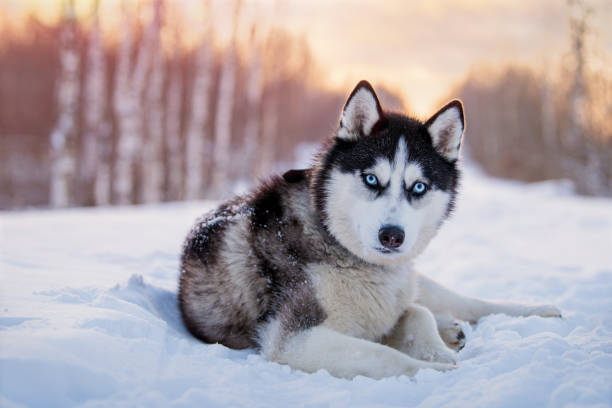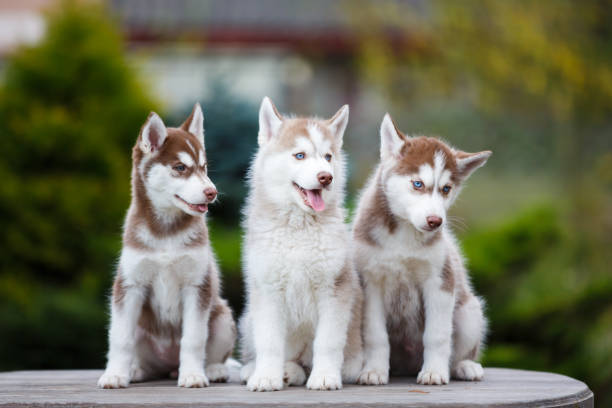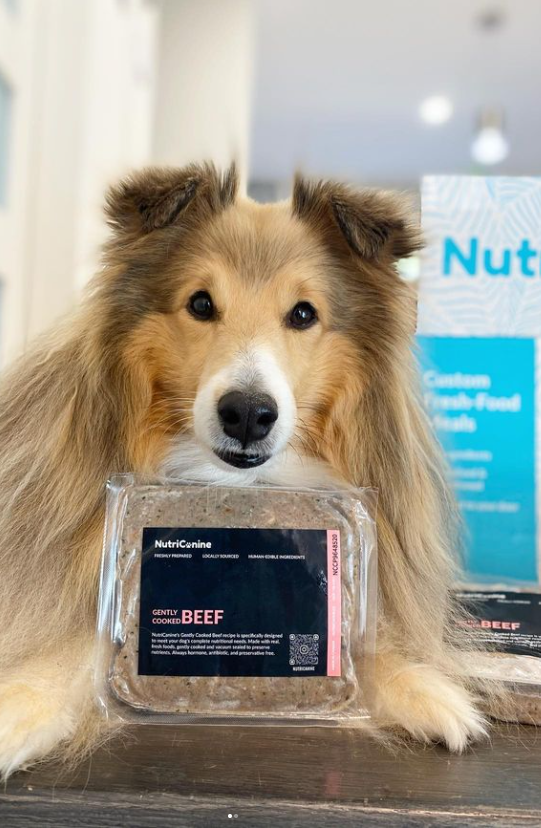“I have three pups, all picky eaters, and they devoured their meals! I’m so happy to have found a quick, easy and super healthy food.”
Quick Stats About the Siberian Husky

Height 20-24 inches

Weight 35-60 lbs
Lifespan 12-15 years
Energy level High
Shedding Heavy
Grooming Moderate
Get a custom meal plan designed specifically for your Siberian Husky
Get StartedSiberian Husky: Everything You Need to Know


The Siberian Husky is a striking and energetic breed known for its endurance, intelligence, and wolf-like appearance. Originally bred as sled dogs by the Chukchi people of Siberia, Huskies are highly active and thrive in cold climates. They have a thick double coat that sheds heavily, especially during seasonal changes. While they are affectionate and friendly, their independent nature means they require consistent training. Huskies are known for their playful personalities, boundless energy, and sometimes stubborn disposition. They are excellent family dogs but need plenty of exercise and mental stimulation to stay happy. Their social nature makes them great companions, though they are prone to escaping if not properly contained. Huskies tend to be vocal, expressing themselves through howls and chatter. They are not typical guard dogs, as they are more likely to befriend strangers than deter them. Providing proper nutrition is key to keeping a Husky in peak condition throughout their life.
Create the Perfect Meal Plan for Your Siberian HuskyCharacteristics and Care
Appearance
Siberian Huskies are medium-sized dogs with a well-muscled build built for endurance. They have a thick double coat that helps insulate them from harsh weather conditions. Their almond-shaped eyes, which can be blue, brown, or a combination of both, give them a striking expression. Huskies are known for their bushy tails, which they often curl over their noses for warmth while sleeping. Their coats come in a variety of colors, including black, gray, red, and pure white, often with unique facial markings.
Temperament
Siberian Huskies are friendly, outgoing, and social dogs. They are known for their playful and mischievous nature, which can make training both fun and challenging. They are pack-oriented dogs, meaning they enjoy the company of other dogs and people. Huskies are not typically aggressive, making them poor guard dogs. They have a strong prey drive and may chase smaller animals if not trained properly. Their independence can make them stubborn, so early socialization and training are crucial.
Grooming
Huskies have a thick double coat that sheds year-round and blows out heavily twice a year. Regular brushing, especially during shedding seasons, helps control the loose fur. Despite their thick coats, they do not have a strong dog odor and typically require only occasional baths. Their nails should be trimmed regularly, and their ears checked for debris. Due to their independent nature, starting a grooming routine early will help them become more comfortable with handling.
Training & Exercise
Siberian Huskies are highly energetic and require significant daily exercise. They excel in activities such as running, hiking, and sled pulling. Without proper exercise, they may develop destructive behaviors. Training a Husky requires patience, as they are intelligent but independent. Positive reinforcement techniques work best, as Huskies respond well to rewards-based training. Due to their high prey drive and tendency to escape, it is essential to train them on-leash and ensure they have a secure, fenced yard.
What Makes a Siberian Husky Unique
Siberian Huskies are unique due to their history as sled dogs, their striking appearance, and their boundless energy. They are one of the most expressive dog breeds, often communicating through howls, whines, and playful chatter. Their ability to withstand extreme cold while remaining active makes them stand out among other breeds. Huskies have an independent streak, which can sometimes come across as stubbornness but is a testament to their strong-willed nature. Unlike many breeds, Huskies do not have a typical dog odor, making them relatively low-maintenance in terms of hygiene. They are known for their mischievous personalities and love of play. Their remarkable endurance and athleticism make them ideal companions for active individuals. Despite their thick coats, they regulate their body temperature efficiently, making them adaptable to various climates. Huskies are social dogs that prefer to be around people or other dogs, making them a poor choice for households where they would be left alone for long periods.
Create a Meal Plan That Caters to Your Siberian Husky’s Unique Needs

Health Considerations for Siberian Huskies
While Siberian Huskies are generally healthy dogs, they are prone to certain breed-specific health issues. Understanding these potential concerns and providing the right care and nutrition can help your Siberian Husky lead a long, happy life.
Eye Conditions
Huskies are susceptible to several eye conditions, including cataracts, progressive retinal atrophy (PRA), and corneal dystrophy. Cataracts can cause cloudiness in the eye, leading to vision impairment, while PRA is a degenerative disease that eventually leads to blindness. Corneal dystrophy affects the clarity of the cornea and may cause discomfort. Regular veterinary eye exams can help detect these issues early and allow for proactive management. Feeding a diet rich in antioxidants such as vitamins C and E, along with omega-3 fatty acids from fish oil, can support long-term eye health. Providing proper nutrition and regular check-ups can help slow the progression of these conditions and maintain your Husky’s vision for as long as possible.
Hip Dysplasia
Hip dysplasia is a genetic condition where the hip joint does not develop properly, leading to arthritis and mobility issues over time. While Siberian Huskies are less prone to this condition compared to other large breeds, it can still develop, particularly in older dogs. Symptoms may include stiffness, difficulty standing up, and reluctance to engage in physical activities. Regular exercise that avoids excessive joint strain, maintaining a lean body weight, and feeding a diet rich in joint-supporting nutrients such as glucosamine and omega-3 fatty acids can help manage and reduce the risk of hip dysplasia. Early detection through veterinary screenings can aid in slowing progression and improving a Husky’s quality of life. In severe cases, medical interventions such as physical therapy or surgery may be required.
Hypothyroidism
Some Huskies develop hypothyroidism, a condition where the thyroid gland does not produce enough hormones, leading to a slower metabolism. Common symptoms include unexplained weight gain, lethargy, hair loss, skin infections, and a dull coat. Affected dogs may also experience cold intolerance and behavioral changes, such as increased anxiety or depression. Diagnosis typically involves blood tests to measure thyroid hormone levels, and treatment often includes lifelong thyroid hormone replacement therapy. Ensuring a well-balanced diet rich in essential nutrients like iodine, selenium, and omega-3 fatty acids can support thyroid health. Regular veterinary check-ups and consistent medication management are key to keeping a Husky with hypothyroidism healthy and active.
Gastric Torsion (Bloat)
Although not as common in Huskies as in deep-chested breeds, bloat (gastric torsion) is a life-threatening condition that can occur suddenly and requires immediate veterinary attention. This condition causes the stomach to fill with gas and twist on itself, leading to severe pain, restricted blood flow, and potential tissue death. Symptoms include a distended abdomen, excessive drooling, restlessness, unsuccessful attempts to vomit, and signs of distress. Risk factors may include eating too quickly, drinking large amounts of water in a short time, and exercising right after meals. Feeding smaller, more frequent meals, using slow-feed bowls, and preventing vigorous activity immediately before or after eating can help reduce the risk. In severe cases, a surgical procedure called gastropexy may be recommended to prevent recurrence.


Nutrition for Every Stage and Need
Every stage of your Siberian Husky’s life—whether puppyhood, adulthood, or their senior years—comes with unique nutritional needs tailored to their age, activity level, and overall health. During puppyhood, they require nutrient-dense meals rich in protein and essential vitamins to support rapid growth and development. As adults, their diet should focus on maintaining energy levels, a healthy weight, and muscle tone, while senior dogs benefit from meals designed to support joint health, cognitive function, and a balanced metabolism. NutriCanine’s fresh, personalized meal plans are crafted to meet these evolving needs, ensuring that your dog receives the perfect balance of high-quality proteins, healthy fats, and essential nutrients at every life stage. By using only fresh, human-grade ingredients and tailoring each recipe to your dog’s specific requirements, NutriCanine helps promote optimal health, vitality, and happiness throughout their life.

Husky puppies require a high-protein diet to support their rapid growth, muscle development, and high energy levels. Their diet should include high-quality animal proteins like chicken, beef, or fish to promote strong muscles and a healthy immune system. Essential fatty acids, such as omega-3 and omega-6, help with brain development and a shiny coat. Since Huskies are naturally lean, feeding them nutrient-dense, properly portioned meals ensures they grow at a healthy rate without excessive weight gain. Providing calcium and phosphorus in balanced amounts is crucial for strong bones and joints, reducing the risk of developmental issues. Hydration and a well-rounded diet with essential vitamins and minerals support their overall well-being as they transition into adulthood.

Adult Huskies thrive on a diet rich in lean proteins, healthy fats, and digestible carbohydrates to fuel their high energy levels and maintain lean muscle mass. High-quality proteins such as chicken, beef, and fish support muscle development and overall health. Healthy fats, including omega-3 and omega-6 fatty acids, promote skin and coat health while providing sustained energy. Digestible carbohydrates like sweet potatoes and brown rice supply essential fiber and help regulate energy levels throughout the day. Since Huskies are naturally efficient at metabolizing food, portion control is crucial to prevent unnecessary weight gain. Hydration is also key, as active Huskies require ample water to stay healthy and perform at their best.

Senior Huskies may need joint-supporting nutrients such as glucosamine and chondroitin to maintain mobility and reduce inflammation. As they age, their cartilage naturally wears down, which can lead to stiffness and discomfort. Omega-3 fatty acids from fish oil can also help reduce joint inflammation and improve overall mobility. A diet rich in antioxidants, such as vitamins C and E, supports immune function and helps combat age-related cellular damage. Additionally, maintaining an ideal weight is crucial to reducing strain on aging joints, making portion control and high-quality, lean proteins essential components of a senior Husky’s diet. Regular veterinary check-ups and adjustments to their diet can help keep senior Huskies active and comfortable in their golden years.

Weight management is crucial for Huskies, as their efficient metabolism and tendency to conserve energy can lead to weight gain, especially if they are not getting sufficient exercise. As they age or become less active, their caloric needs decrease, making portion control and a well-balanced diet essential. A diet rich in lean proteins, fiber, and low-glycemic carbohydrates helps maintain an ideal weight without unnecessary fat accumulation. Regular physical activity, such as structured walks or interactive play, helps keep their weight in check and prevents obesity-related health issues. Additionally, incorporating omega-3 fatty acids can support metabolism and reduce inflammation, further promoting a healthy weight. Monitoring portion sizes and avoiding excessive treats ensures Huskies remain lean and active throughout their lives.

Some Huskies have food sensitivities and may benefit from limited-ingredient diets that exclude common allergens like chicken, wheat, or soy, focusing instead on novel proteins and easily digestible carbohydrates.
The Nutrition Your Dog Deserves
NutriCanine’s personalized meal plans provide your Siberian Husky with fresh, human-grade ingredients tailored to their unique needs. From puppies to seniors, our recipes are formulated to deliver complete and balanced nutrition for every life stage. By choosing NutriCanine, you’re ensuring your dog receives the best possible care through high-quality meals that they’ll love.
Dogs 101 - Siberian Husky
Ready to Provide the Best Nutrition for Your Siberian Husky?
NutriCanine’s personalized meal plans are designed to meet the unique nutritional needs of your Siberian Husky. Our fresh, high-quality ingredients ensure your dog gets the best possible nutrition. Start your journey to better health and happiness for your Siberian Husky today.
Our Gently Cooked Recipes
- Guided by science
- Made fresh daily
Our recipes, developed by an agronomist, are nutrient-rich, delicious, and complete and balanced, meeting AAFCO guidelines.

Chicken Recipe
Bowl lickin' good - bet we don't keep our recipe a secret! For healthier skin and coat with nutrient-dense broccoli and carrots.
Learn More
Turkey Recipe
Just like your Thanksgiving meal, but specially designed for your dog. For improved digestibility, enhanced by superfood kale and butternut squash.
Learn More
Beef Recipe
Perfect for the pickiest eaters and gluten-sensitive dogs with highly digestible rice and antioxidant-rich berries.
Learn More
Lamb Recipe
Designed for dogs with allergies and sensitivities, enriched by nutrient-packed green beans and carrots.
Learn More
Pork Recipe
Wrap your dog in comfort with every bowl - soothing relief for itchy skin and sensitive tummies, with irresistible flavour.
Learn More Verified Purchase
Verified Purchase